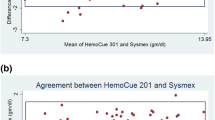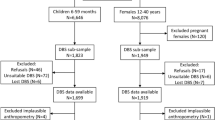Abstract
Objective : This piece of work is an attempt to compare Hemocue and Cyanmethemoglobin methods for hemoglobin estimation.Methods : In 100 apparently healthy children of 1–6 years of age, Hb was estimated using Hemocue and cyanmethemoglobin methods from finger prick blood sample. The results, obtained by the two methods were compared using appropriate statistical methods.Results : Mean ±SD values for hemoglobin (g/dl) were 9.33 ±2.719 by Hemocue and 8.14 ±2.448 by cyanmethemoglobin method. When assessed by Hemocue method the proportion of children with anemia was 66% while it was 88% with cyanmethemoglobin method. The sensitivity of Hemocuc method was 0.75 and specificity 1.0 considering cyanmethemoglobin method as gold standard. The corresponding values by cyanmethemoglobin method for a given Hemocue value fell within the Mean difference ±2 SD with correlation coefficient being r = 0.922. Despite the good association, the two methods agreed, the magnitude of difference being -1.19 g/dl (CI: -1.40 to —0.98) thus suggesting an overestimate of hemocue values ranging from 10 to 15%. A correction factor was arrived for converting Hb values obtained by Hemocue method to arrive at the expected value by the reference method, this factor being 0.389 + 0.831 Hb (Hemocue).Conclusion : As there are limitations expressed for both the methods in accurately estimating Hb, it is difficult to decide whether one is an overestimate or the other an underestimate. By virtue of the principle involved in estimating Hb, cyanmethemoglobin method may be taken as an indirect indicator of iron status. However, it is not clear whether such a principle is involved in estimating Hb by Hemocue. Therefore, these two methods need to be further validated against a sensitive and specific indicator for iron status like circulating transferrin receptor to decide which of the methods can be used to accurately determine the prevalence of iron deficiency anemia in the community
Similar content being viewed by others
References
International Committee for Standardization in Hematology.Br J Haematol 1967; 13 (Suppl), 68–75.
Vanzetti G. An azide-methemoglobin method for hemoglobin determination in blood.J Lab Clin Med 1966; 67:116–126.
Hamill PW, Drizd TA, Johnson CL, Reed RB, Roche AF. NCHS Growth Curves for children-18 years. InVital and Health Statistics. Hyattesrville, Md. DHEW Publications: US. National Centre for Health Statistics 1977; 165:1–74.
Neville RG. Evaluation of portable haemoglobinometer in general practice.Br Med J 1987; 294:1263–1265.
Dacie JV, Lewis SM, eds.Practical Hematology. New York, 6th edn. Churchill Livingstone: 1984:28-30.
Bland JM, Altman DG. Statistical methods for assessing agreement between two methods of clinical measurement.Lancet 1986; 1:307–310.
van Kampen EJ, Assendelft DW. Quality control and hematology. In Anido G, van Kampen EJ, Rosalki SB, Rubin M, eds.Quality Control in Clinical Chemistry. Berlin-New York; de Gruyter, 1975; 325–333.
Creer MH, Ladenson J. Analytical errors due to lipemia.Lab Med 1983; 14:351–355.
Sharma A, Artiss JD, Strandbergh DR, Zak B. The turbid specimen as an analytical medium: hemoglobin determination as a model.Clin Chim Acta 1985; 147:7–14.
Von Schenck H, Falkensson M, Lundberg B. Evaluation of “Hemocue,” a New Device for Determining Hemoglobin.Clin Chemistry 1986; 32:526–529.
Mills AF, Meadows N. Screening for anaemia: Evaluation of a hemoglobino meter.Arch Dis Child 1989; 64 :1468–1471.
Cohen AR, Friedman J. Hemocue System for Hemoglobin Measurement: Evaluation in Anemic and Non-anemic Children.Am J Clin Pathol 1988; 90 :302–305.
Zijlstra WG, Van Kampen EJ. Standardization of Hemoglobinometry. 1. The Extinction coefficient of Hemoglobincyanide at 1 = 540 mm: S 540 HICN.Clin Chim Acta 1960; 5:719–726.
Skikne BS, Flowers CH, Cook JD. Serum Transferrin Receptor: A quantitative measure of tissue iron deficiency.Blood 1990; 75:1870–1876.
Author information
Authors and Affiliations
Corresponding author
Rights and permissions
About this article
Cite this article
Bhaskaram, P., Balakrishna, N., Radhakrishna, K.V. et al. Validation of hemoglobin estimation using hemocue. Indian J Pediatr 70, 25–28 (2003). https://doi.org/10.1007/BF02722739
Issue Date:
DOI: https://doi.org/10.1007/BF02722739




